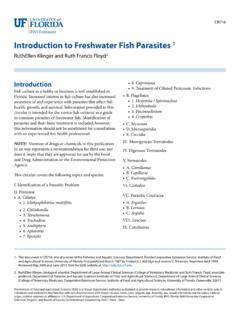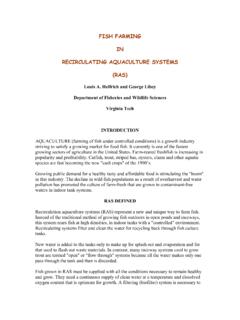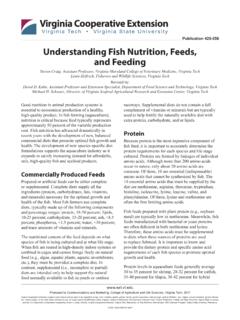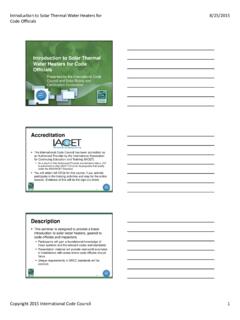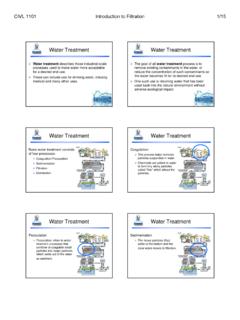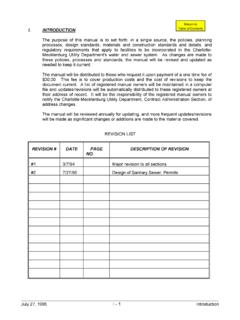Transcription of An Introduction to Water Chemistry in Freshwater ...
1 NRAC Fact Sheet No. 170-1993 AquacultureCenterUniversity of MassachusettsDartmouthNorth DartmouthMassachusetts 02747An Introduction to Water Chemistryin Freshwater AquacultureJoseph K. Buttner, SUNY College at BrockportRichard W. Soderberg, Mansfield UniversityDaniel E. Terlizzi, University of Maryland Sea Grant Extension ProgramThe major Water quality factors that are important infreshwater aquaculture systems and methods to monitorthem are described in this publication. Water quality de-termines not only how well fish will grow in an aquacul-ture operation, but whether or not they survive. Fish in-fluence Water quality through processes like nitrogenmetabolism and respiration. Knowledge of testing proce-dures and interpretation of results are important to the Water quality factors are more likely to be in-volved with fish losses such as dissolved oxygen, temper-ature, and ammonia. Others, such as pH, alkalinity, hard-ness and clarity affect fish, but usually are not directlytoxic.
2 Each Water quality factor interacts with and influ-ences other parameters, sometimes in complex may be toxic and cause mortalities in one situation,can be harmless in another. The importance of each fac-tor, the determination method and frequency of monitor-ing depends upon the type and rearing intensity of theproduction system Quality VariablesTemperatureAll biological and chemical processes in an aquacultureoperation are influenced by temperature. Fish adjust theirbody temperature and metabolic rate by moving into cool-er or warmer Water . Each species has a preferred or opti-mum temperature range where it grows best. At tempera-tures above or below optimum, fish growth is may occur at extreme OxygenThe minimum dissolved oxygen (DO) level that fish cansafely tolerate depends upon temperature and to a certainextent the species. Volubility of oxygen increases as tem-perature decreases. In ponds, DO can change dramaticallyover a 24 hour period.
3 During the day oxygen is producedby photosynthesis, the process by which green plants con-vert Water and carbon dioxide in the presence of light, tooxygen and carbohydrates. During the night and day oxy-gen is consumed by respiration, the process by whichplants and animals use oxygen to produce carbon dioxideas they burn carbohydrates, but in the day photosynthesisusually produces more oxygen than is used. Typically,oxygen levels are lowest just before dawn and highest inthe late in a culture system must be maintained above lev-els considered stressful to fish. Warmwater fish (speciesthat grow best at temperatures above 80 F) can toleratelower DO concentrations than coldwater fish (species thatgrow best at temperatures below 60 F). As a rule ofthumb, DO should be maintained above ppm (partsper million; frequently used interchangeably with milli-grams per liter, mg/L) and ppm for warm and coldwa-ter fish, respectively. Prolonged exposure to low, non-lethal levels of DO constitutes a chronic stress and willcause fish to stop feeding, reduce their ability to convertingested food into fish flesh, and make them more suscep-tible to disease.
4 Intensive fish production in ponds, cages,flow-through, and recirculating systems requires aerationor oxygenation to maintain DO at safe WastesMost fish and Freshwater invertebrates excrete ammoniaas their principle nitrogenous waste. Analytical methodsare used to determine total ammonia-nitrogen (TAN). Theproportion of TAN that exists in ionized and un-ionizedform varies with pH and temperature. As pH and temper-ature increase, the amount of TAN in the toxic un-ionizedform increases (see figure 1). Fish continuously exposedto more than ppm of the un-ionized form may exhib-it reduced growth and increased susceptibility to fish are cultured intensively and fed protein-richfeeds they can produce high concentrations of ammoniain the Water . Ammonia and other metabolic wastes aregradually removed by natural processes in ponds orthrough the use of biological filters in recirculating andreuse systems. Ammonia is removed by bacteria that ini-tially convert it into nitrite and subsequently into is toxic to fish and causes brown blood of ppm have reduced growth and ad-versely affected fish.
5 Fish can tolerate nitrate to severalhundred ppm. Removal or detoxification of ammonia isfacilitated by providing and maintaining an optimal envi-ronment for the appropriate bacteria (pH between 7-9;temperature approximately 75-85 F).78910pHFigure 1. Relationship between pH, temperature, and un-ionized ammonia at 61 F and 82 FpHThe concentration of bases and acids in the Water deter-mines its pH. A low pH is acidic and a high pH is basic; apH of 7 is neutral. Fish survive and grow best in waterswith a pH between 6-9. If pH readings are outside thisrange, fish growth is reduced. At values below orabove 10, mortalities well-buffered ponds (with alkalinity over 50-100ppm, see next section), pH typically fluctuates one or twounits daily. In the morning, carbon dioxide levels are highand pH is low as a result of respiration during the night(carbon dioxide forms a mild acid when dissolved in wa-ter).
6 After sunrise, algae and other green plants producecarbohydrates and oxygen from carbon dioxide and waterby photosynthesis. As carbon dioxide is removed from thewater, its pH increases. The lowest pH of the day is typi-cally associated with the lowest level of dissolved oxy-gen. The highest pH of the day is typically associatedwith the highest level of dissolved recirculating systems, vitrification and respirationof both fish and biofilter bacteria decrease pH. Frequent-ly, a buffer such as sodium bicarbonate is added to pre-vent the pH from falling too buffering capacity of culture Water , expressed as ppmcalcium carbonate, is its alkalinity. Alkalinity is a measure-ment of carbonate and bicarbonate ions (ions are atoms orgroups of atoms with a negative or positive charge) dis-solved in the Water . As the amount of carbon dioxide fluc-tuates, the pH of Water changes. The magnitude of thisshift is determined by the Water s buffering capacity or itsability to absorb acids and/or bases.
7 Photosynthetic activityin a poorly buffered pond can cause pH to increase, per-haps from as low as six in the morning to nine or more bylate afternoon. In a pond with higher alkalinity, the pH shiftis reduced. For instance, the daily shift in a well bufferedpond might be from a pH of seven in the morning to eightby late afternoon. A suitable range of alkalinity is 20 to 300ppm. Alkalinity in excess of 300 ppm does not adverselyaffect fish, but it does interfere with action of certain com-monly used chemicals ( , copper sulfate). Alkalinity re-mains relatively constant in ponds, but decreases steadilyin nonsupplemented, recirculating systems. Alkalinity canbe increased by adding agricultural limestone to ponds orsodium bicarbonate to recirculating and magnesium ions comprise hardness. Test pro-cedures usually determine both ions as total hardness, ex-pressed as ppm calcium carbonate.
8 In most waters the con-centrations of alkalinity and hardness are similar, but theycan differ vastly as alkalinity measures negative ions (car-bonate, bicabonate) and hardness measures positive ions(calcium, magnesium). Hardness is important, especially inthe culture of several commercial species such as stripedbass and catfish. If hardness is deficient, these species donot grow well. Hardness should be above 50 ppm; lowhardness can be adjusted by the addition of lime or DioxideOnly when using groundwater, transporting fish at highdensities, or in recirculating systems are carbon dioxideproblems likely to develop. At high concentrations, carbondioxide causes fish to lose equilibrium, become dis-oriented and possibly die. Testing groundwater before useand aerating it, if necessary, will reduce carbon dioxide toacceptable levels. Careful planning, aeration or oxygena-tion, and buffering of Water will keep carbon dioxide at ac-ceptable levels when large numbers of fish are hauled ex-tended distances or cultured in recirculating total concentration of all ions in the Water is its fish exhibit a range in salinity tolerance.
9 Manycommercially important species ( , channel catfish, Ictal-urus punctatus; largemouth bass, Micropterus salmoides; ti-lapia, Tilapia sp.) survive and grow well in slightly saltywater. After they smelt, salmon and trout can tolerate saltwater. Salinity not only affects osmoregulation it also influ-ences the concentration of un-ionizedammonia. During theplanning stage of an aquaculture operation, salinity shouldbe measured and the Water s appropriateness groundwaters contain elevated levels of dissolvediron. When exposed to the air, this iron interacts with oxy-gen, becomes insoluble, and forms a red deposit. Smallclumps of iron are produced that can settle on fish gills,causing irritation and stress. Problems can be avoided if theiron-bearing Water is exposed to air and the resultantclumps of iron removed by settling or filtration before thewater enters the culture control bacteria, municipal Water supplies are typicallytreated with chlorine at ppm.
10 If municipal waters areused to culture fish, residual chlorine must be removed byaeration, with chemicals such as sodium thiosulfate, or fil-tration through activated charcoal. Chlorine levels as low ppm can stress SulfidePonds with oxygen-poor bottoms and accumulated organicmaterial can release hydrogen sulfide when seined or dis-turbed. Substratum beneath heavily fed cages/net pens canaccumulate wastes ( , uneaten food, feces) and producehydrogen sulfide gas if oxygen becomes deficient. Hydro-gen sulfide gas has a rotten egg odor and is extremely toxicto fish. Any detectable odors or levels should be avoidedand extreme care should be taken when handling fish in anafflicted pond. Ponds can be drained, exposed to air and/orexcavated to correct the ClarityIn pond and cage culture, Water clarity can affect fish. Iffish that prefer turbid waters ( , bullhead, catfish, wall-eye) are cultured in relatively clear Water they will experi-ence stress; survival and growth will be adversely of suspended solids and discoloration of cul-ture Water occur in recirculating systems which can irritatefish and precipitate disease.
